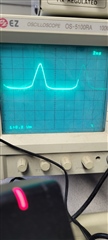The SN74HC14PWR was changed from HCMOS to LBC9 process, along with a number of other ICs. This was done under PCN 20200629000.1 by TI.
We are finding that the LBC9 parts are susceptible to radiated EMI Interference in the high frequency 9 - 300 MHz range. The original HCMOS parts show no sensitivity to the EMI whatsoever. The EMI affects both the Input and Output of the individual Schmitt Trigger inverter gates in this LCB9 process package.
I have attached:
- The PCN 20200629000.1 from TI
- The Oscilloscope screen captures of the distorted Input and Output signals of the SN74HC14PWR
- The schematic of the circuit affected by the EMI
The source of the EMI is from a small Ozonator, used on a Walk-In Bath, to sanitize the bath water. If it plugged into the same AC outlet as our controller, we get the HC14 waveform distortion. It gets worse when the Ozonator is placed beside the control box.
I can eliminate about 70% of the noise with a 27pF ceramic capacitor on the Schmitt Trigger input to VRet, but I have not been able to resolve the interference completely.
The output of the Schmitt Trigger runs the Keyboard Interrupt of a Freescale HCS05PA16 processor. I am getting extra (false) interrupts from the HC14 because of this interference.
I wrote special software to accept the first interrupt request, then block other interrupts for 5 ms. It is a zero cross detection circuit, to keep track of time, and provide a phase angle reference for firing a Triac on the AC Line. We would like to completely correct the EMI noise problem on the HC14 instead of having to mask the problem.
What specific part of the PCN die process change would have caused this IC to be susceptible to the EMI?
Thank you for your help with this!




